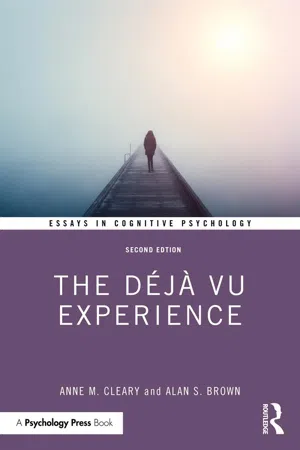
- 264 pages
- English
- ePUB (mobile friendly)
- Available on iOS & Android
The Déjà Vu Experience
About this book
The Déjà vu Experience, Second Edition covers the latest scientific discoveries regarding the strange sense of familiarity most of us have felt at one time or another when doing something for the first time. The book sheds light on this mysterious phenomenon, considering the latest neurophysiological investigations and research on possible reasons why déjà vu is often associated with a sense of predicting the future or knowing what happens next.
In addition to summarizing the major historical and contemporary theoretical approaches to the déjà vu experience, this book aspires to stimulate additional research on this curious subjective phenomenon. Drawing on research from a range of fields including psychology, philosophy, and religion, it aims to demystify some of the more unsettling, spooky-seeming aspects of the déjà vu experience, elucidating possible mechanisms and underlying reasons for its occurrence. This edition has been thoroughly updated throughout to include over 200 new professional articles and book chapters related to déjà vu that have been published in the 18 years since the original book.
By placing the scientific study of déjà vu within its historical context and covering a broad range of perspectives on the subject, this title will be invaluable to upper-level undergraduates, postgraduates, and researchers of Cognitive Psychology, specifically those focusing on Memory Phenomena.
Frequently asked questions
- Essential is ideal for learners and professionals who enjoy exploring a wide range of subjects. Access the Essential Library with 800,000+ trusted titles and best-sellers across business, personal growth, and the humanities. Includes unlimited reading time and Standard Read Aloud voice.
- Complete: Perfect for advanced learners and researchers needing full, unrestricted access. Unlock 1.4M+ books across hundreds of subjects, including academic and specialized titles. The Complete Plan also includes advanced features like Premium Read Aloud and Research Assistant.
Please note we cannot support devices running on iOS 13 and Android 7 or earlier. Learn more about using the app.
Information
Part I
1
“Last Wednesday, I was at home with both my parents around. I was revising a term paper, around 1 am. I felt a sensation that told me that I had revised that paper before. I felt strange because the minute I highlighted the word ‘wander,’ I got a sense that it had happened already. I even said out loud the word ‘déjà vu’ when I received that sensation.”
“Last summer, I was in a program at Galveston. I was sitting with my roommate and we were talking about our problems. After a few minutes of talking, I experienced déjà vu. I don’t know if I had dreamed that experience or what, but it felt as if it was recurring.”
“We visited a discothèque in Downtown Disney, and were dancing with two girls from Brazil. Neither one of us had been there before, or had met the girls before. However, when a song played I felt as if I had lived the moment before. I couldn’t remember exactly when or where, but I knew it wasn’t my first time there and with them.”
A Brief Historical Context for the Study of Déjà Vu
Table of contents
- Cover
- Half Title
- Series Page
- Title Page
- Copyright Page
- Contents
- List of Figures
- Preface
- Acknowledgments
- PART I: The Study of Déjà Vu
- PART II: Factors Related to Déjà Vu
- PART III: Theory
- PART IV: Summary and Future Directions
- References
- Author Index
- Subject Index